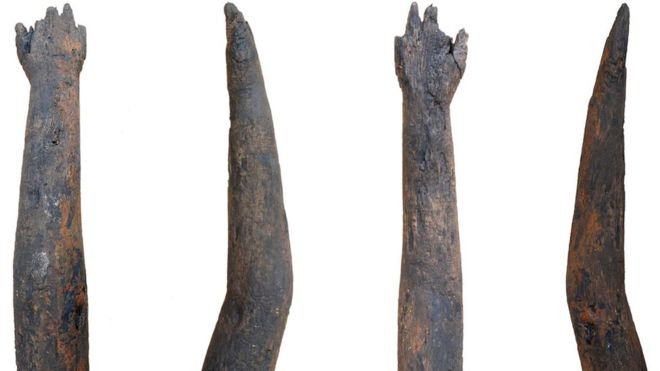Blog
Roman Britain: Wooden arm discovered in Northamptonshire well
- di
- 25 Giu 2019 alle 22.58
Focus Cronache archeologiche Ritrovamenti Braccia di legno
The "finely carved" limb was found by archaeologists excavating land at the Warth Park industrial estate in Raunds, Northamptonshire.
Experts believed the discovery is of national and international importance, because of its location - and survival.
Wood specialist Michael Bamforth said it may have been an offering to the gods.
Archaeologists from Oxford Archaeology East said the arm survived in the water-logged well as it had been filled in at the top so a lack of oxygen prevented deterioration.
Mr Bamforth said the artefact was "carved from a single branch, which makes use of a natural curve to form the elbow, and is very well made, as no tool marks are visible on its surface".
He said the "slender and gracile" nature of the hand suggested it had been modelled to "mimic the arm and hand of a small adult or adolescent".
The unusual find is close to a 4,000-year-old "henge", first discovered by aerial photography in the 1970s and uncovered for the first time by archaeologists in April 2018.
Experts also believe it did not belong to a full sculpture as there is "no trace of any jointing".
A small fragment of the arm was carbon-dated to reveal it was made in the earlier British Roman sometime between 86 and 240 AD, which corresponds with Roman pottery also recovered from the well.
"It seems likely that it was just this specific element of the body, which was represented and singled out as being in some way significant for votive deposition [religious offering]," Mr Bamforth said.
"This wooden arm represents an incredibly rare artefact that holds at least national, and perhaps even international, importance."
Experts believed the discovery is of national and international importance, because of its location - and survival.
Wood specialist Michael Bamforth said it may have been an offering to the gods.
Archaeologists from Oxford Archaeology East said the arm survived in the water-logged well as it had been filled in at the top so a lack of oxygen prevented deterioration.
Mr Bamforth said the artefact was "carved from a single branch, which makes use of a natural curve to form the elbow, and is very well made, as no tool marks are visible on its surface".
He said the "slender and gracile" nature of the hand suggested it had been modelled to "mimic the arm and hand of a small adult or adolescent".
The unusual find is close to a 4,000-year-old "henge", first discovered by aerial photography in the 1970s and uncovered for the first time by archaeologists in April 2018.
Experts also believe it did not belong to a full sculpture as there is "no trace of any jointing".
A small fragment of the arm was carbon-dated to reveal it was made in the earlier British Roman sometime between 86 and 240 AD, which corresponds with Roman pottery also recovered from the well.
"It seems likely that it was just this specific element of the body, which was represented and singled out as being in some way significant for votive deposition [religious offering]," Mr Bamforth said.
"This wooden arm represents an incredibly rare artefact that holds at least national, and perhaps even international, importance."

Links and Media
Altri Articoli
-

Pompei, Torna alla luce la bottega dello street food (ANSA)
- di Grazia Pattumelli
- 26 Dec 2020 alle 15.19
-

Spada e ascia dell’Età del Bronzo trovate in Repubblica Ceca (Il Fatto Storico)
- di Grazia Pattumelli
- 18 Dec 2020 alle 17.53
-

Pompei, gli scavi rivelano
- di Grazia Pattumelli
- 15 Dec 2020 alle 10.57
-

Roma, testa monumentale di Augusto scoperta sulla via di Alessandrina (Corriere della Sera)
- di Grazia Pattumelli
- 12 Dec 2020 alle 10.07

